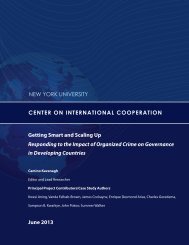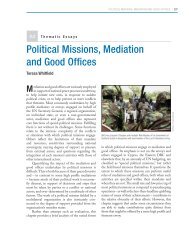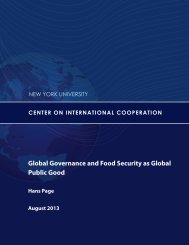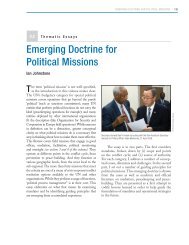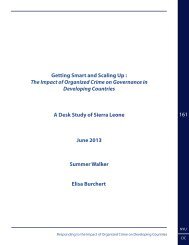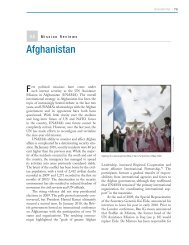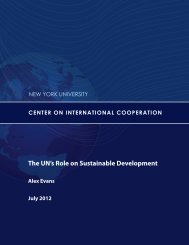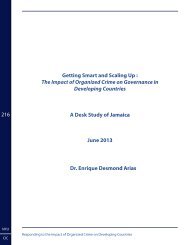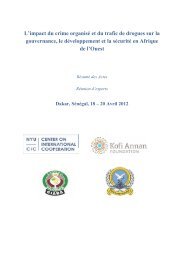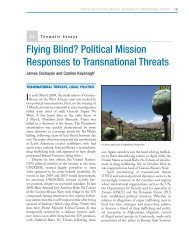here - Center on International Cooperation - New York University
here - Center on International Cooperation - New York University
here - Center on International Cooperation - New York University
You also want an ePaper? Increase the reach of your titles
YUMPU automatically turns print PDFs into web optimized ePapers that Google loves.
epresentatives and journalists visiting the United States<br />
between August 2012 and February 2013, secti<strong>on</strong>s in this<br />
chapter <strong>on</strong> political processes and crime developments in<br />
Nepal since the period of fieldwork have been kept up-todate.<br />
The structure of the case study is as follows. Secti<strong>on</strong> I<br />
discusses the political, instituti<strong>on</strong>al, social, and regi<strong>on</strong>al<br />
c<strong>on</strong>text. It elaborates the current political c<strong>on</strong>testati<strong>on</strong><br />
in Nepal, new processes of inclusi<strong>on</strong> and caste and<br />
ethnic mobilizati<strong>on</strong>, as well as deeply-entrenched<br />
norms of patr<strong>on</strong>age, clientelism, and corrupti<strong>on</strong>. It also<br />
provides an overview and assessment of key justice and<br />
law enforcement instituti<strong>on</strong>s, which have a particularly<br />
important bearing <strong>on</strong> crime. Finally, it situates domestic<br />
political processes within the c<strong>on</strong>text of the geostrategic<br />
c<strong>on</strong>testati<strong>on</strong> in which Nepal finds itself. In the first part<br />
of Secti<strong>on</strong> II, the chapter analyzes crime in support of<br />
political objectives. The areas covered include the role<br />
of crime and illicit ec<strong>on</strong>omic activities in bandhs, party<br />
fundraising (with a focus <strong>on</strong> the Maoist and Madhesi<br />
groups), tender acquisiti<strong>on</strong>, and the usurpati<strong>on</strong> of public<br />
funds. The sec<strong>on</strong>d part of this secti<strong>on</strong> reviews the role<br />
of crime in Nepal in support of internati<strong>on</strong>al terrorism<br />
and geostrategic competiti<strong>on</strong>. In the third part, Secti<strong>on</strong><br />
II discusses ec<strong>on</strong>omically-motivated crime in Nepal,<br />
including tax evasi<strong>on</strong> and extorti<strong>on</strong>, drug producti<strong>on</strong> and<br />
trafficking, illegal logging, illegal trade in wildlife, and<br />
human trafficking. Secti<strong>on</strong> III discusses the d<strong>on</strong>or c<strong>on</strong>text<br />
and the effectiveness of various d<strong>on</strong>or initiatives to<br />
reduce corrupti<strong>on</strong> and promote good governance. After<br />
the c<strong>on</strong>clusi<strong>on</strong>s presented in Secti<strong>on</strong> IV, Secti<strong>on</strong> V offers<br />
recommendati<strong>on</strong>s.<br />
I. The Political, Instituti<strong>on</strong>al, Social and<br />
Regi<strong>on</strong>al C<strong>on</strong>text<br />
Political C<strong>on</strong>testati<strong>on</strong>, Social Exclusi<strong>on</strong>, and<br />
Corrupti<strong>on</strong><br />
For several years, Nepal has teetered between upheaval<br />
and stagnati<strong>on</strong>. Over the past two decades, its people<br />
have witnessed the transiti<strong>on</strong> from an authoritarian<br />
Hindu kingdom to a c<strong>on</strong>stituti<strong>on</strong>al m<strong>on</strong>archy in 1991; the<br />
incomplete democratizati<strong>on</strong> of the 1990s; the massacre<br />
of members of the royal family in 2001 by the heir to the<br />
thr<strong>on</strong>e; a decade-l<strong>on</strong>g civil war between Maoist insurgents<br />
and the government that ended in a faltering peace<br />
agreement in 2006; and the removal of the m<strong>on</strong>archy<br />
altogether in 2008. Particularly since 2008, when for the<br />
first time in centuries many marginalized groups acquired<br />
a voice in the political sp<str<strong>on</strong>g>here</str<strong>on</strong>g>, the country has oscillated<br />
between increasingly violent, politically-orchestrated<br />
chaos and paralysis. At the core of the political upheaval is<br />
the fundamental transformati<strong>on</strong> of a deeply-rooted feudal<br />
system to a more inclusive <strong>on</strong>e, albeit <strong>on</strong>e whose level of<br />
openness and accessibility still c<strong>on</strong>tinues to be c<strong>on</strong>tested.<br />
The fitful struggle since 2006 to develop a new c<strong>on</strong>stituti<strong>on</strong><br />
is both a symptom and driver of the country’s multiple<br />
ethnic, religious, geographic, caste, and class divisi<strong>on</strong>s.<br />
More than 90 languages are spoken in Nepal, and<br />
Buddhists and Muslims are sizable minorities am<strong>on</strong>g the<br />
largely Hindu populati<strong>on</strong>. Many of these cleavages have<br />
been suppressed for centuries, particularly during the 20th<br />
century when the ruling royal family squashed all but the<br />
caste divisi<strong>on</strong>s. However, recent political liberalizati<strong>on</strong> and<br />
democratizati<strong>on</strong> have str<strong>on</strong>gly intensified communal selfidentificati<strong>on</strong><br />
and self-determinati<strong>on</strong> processes. Political<br />
competiti<strong>on</strong> has played a central role in playing up and<br />
exploiting such cleavages and “democratic” politics by<br />
catering to the interests of ethnic, class, or caste-based<br />
groups. Despite the political empowerment of many<br />
previously voiceless groups, the post-2006 c<strong>on</strong>stituti<strong>on</strong><br />
drafting process has become a frenzied c<strong>on</strong>test to secure<br />
special privileges for <strong>on</strong>e’s own parochial group, rather<br />
than a process to redress l<strong>on</strong>g-standing grievances while<br />
unifying the country.<br />
59<br />
Resp<strong>on</strong>ding to the Impact of Organized Crime <strong>on</strong> Developing Countries<br />
NYU<br />
CIC



